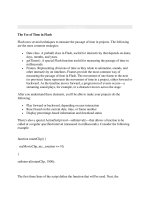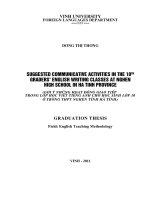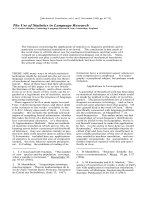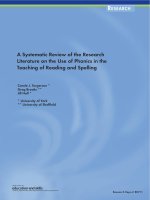Investigating the use of videos in english language classrooms at an upper secondary school in ha tinh province
Bạn đang xem bản rút gọn của tài liệu. Xem và tải ngay bản đầy đủ của tài liệu tại đây (1.15 MB, 79 trang )
MINISTRY OF EDUCATION AND TRAINING
VINH UNIVERSITY
VO THI VIET ANH
INVESTIGATING THE USE OF VIDEOS IN ENGLISH
LANGUAGE CLASSROOMS AT AN UPPER
SECONDARY SCHOOL IN HA TINH PROVINCE
MASTER’S THESIS IN EDUCATION
Nghe An, 2018
MINISTRY OF EDUCATION AND TRAINING
VINH UNIVERSITY
VO THI VIET ANH
INVESTIGATING THE USE OF VIDEOS IN ENGLISH
LANGUAGE CLASSROOMS AT AN UPPER SECONDARY
SCHOOL IN HA TINH PROVINCE
Major: Teaching English to Speakers of Other Languages
(TESOL)
Code: 80140111
MASTER’S THESIS IN EDUCATION
SUPERVISOR:
Nguyen Gia Viet, Ph.D.
Nghe An, 2018
ABSTRACT
This research was carried out with teachers of English and grade 10th
students at an upper secondary school located in the South of Ha Tin province to
investigate the use of video clips in teaching and learning English.The thesis
aimed to find out how video clips in English lessons help to achieve the goals of
the English curriculum. The main hypothesis was that teaching with video clips
would develop pupils‟ communicative skills and, therefore, would be appropriate
for the communicative approach to ELT.
The study addressed four research questions regarding the use of video
clips in English lessons in the case study school: to what extent were video clips
used in ELT, for what purposes the teachers and students used video clips, what
experiences the teacher and students had in using video clips, and what
suggestions the teachers recommended on using video clips in teaching English.
The research was performed as a case study in an upper secondary school
in Ha Tinh province. The data for the research was obtained through the use of
mixed methods: qualitative, in the form of questionnaires answered by twelve
English teachers, and quantitative, in the form of questionnaire answered by
more than 80 students in grade 10.
Video clips appeared to have a positive impact on the development of the
pupils‟ four language skills and vocabulary growth, as well as to scaffold the
process of acquiring the pragmatic use of the language and to teach about the
target language cultures. By and large, both the teachers and the students had
positive attitudes to lessons with video clips.
i
The findings of the study suggested that teaching with video clips can
effectively promote communicative language teaching, bring variety into ELT
classrooms, motivate pupils to learn a foreign language, benefit the development
of the four language skills and vocabulary growth, supplement texts in
textbooks, and approach the curriculum topics via a different medium.
The thesis has contributed to the knowledge on the use of one of the
digital media, namely video clips, in ELT in an upper secondary school and, to
the best of the researcher‟s knowledge, has contributed to a gap in the research in
this field.
ii
ACKNOWLEDGEMENTS
I have been fortunate to receive invaluable help from many people
during my assignment.
First, I would like to express my deepest gratitude to Dr. Nguyen Gia
Viet, my supervisor, for his immense encouragement, whole hearted and
detailed guidance, without which the assignment could not have been
completed.
I would like to thank all the teachers who have taught me during the
course and have given me useful advice and favorable conditions for the
completion of the thesis.
I also would like to show my special thanks to teachers of English and
students in the upper secondary school where I conducted the research, who
help me a lot in accompanying with me during the research, answering all of
my questionnaires, giving their invaluable comments, efforts and
contributions while the work of this assignment was in progress.
Last but not least, I also owe my indebtedness to my family and
colleagues for their kind co-operation and encouragement which help me in
completion of this study.
Nghe An, July 2018
iii
TABLE OF CONTENTS
ABSTRACT ............................................................................................................i
ACKNOWLEDGEMENTS ................................................................................. iii
TABLE OF CONTENTS ......................................................................................iv
LIST OF ABBREVIATIONS ...............................................................................vi
LIST OF TABLES .............................................................................................. vii
LIST OF FIGURES............................................................................................ viii
CHAPTER I. INTRODUCTION ....................................................................... viii
1.1 Introduction ...................................................................................................... 1
1.2. Rationale..........................................................................................................2
CHAPTER II. LITERATURE REVIEW...............................................................4
2.1 Definition of a video clip .................................................................................4
2.2 Why use video in the classroom? ..................................................................... 6
2.2.1 Principles of Learning ...................................................................................6
2.2.2 Video in the ESL classroom..........................................................................8
2.3 A brief history of video clips use in English teaching ..................................... 9
2.4 Potentially positive aspects of using video for English teaching...................12
2.5 Problematical aspects of using video for teaching English ...........................16
2.6 Summary ........................................................................................................16
CHAPTER III. METHODOLOGY .....................................................................19
3.1. Research questions ........................................................................................19
3.2. Participants ....................................................................................................19
3.3 Instruments .....................................................................................................21
3.4 Procedure ........................................................................................................23
iv
CHAPTER IV. FINDINGS AND DISCUSSIONS .............................................26
4.1. Results ...........................................................................................................26
4.1.1 The extent of video use in class ..................................................................27
4.1.2. Purposes of using video clips in teaching ..................................................32
4.1.3. Teachers‟ and students‟ experiences in using video clips in EFL classrooms..38
4.1.4. Teachers suggestions about use of video clips in English teaching ..........42
4.2. Discussion .....................................................................................................45
CHAPTER V. CONCLUSION ............................................................................50
5.1. Overview of the thesis ...................................................................................50
5.2. Pedagogical implications ..............................................................................51
5.2.1. Implications for administrators ..................................................................51
5.2.2. Implications for high school teachers ........................................................52
5.2.3. Implications for high school students ........................................................54
5.3 Limitations .....................................................................................................55
5.4 Suggestions for further research.....................................................................55
v
LIST OF ABBREVIATIONS
1. EFL: English as Foreign Language
2. ESL: English as a second language
3. NS: native speakers
vi
LIST OF TABLES
Table 3.1 Demographic information of student participants ...............................19
Table 3.2 Demographic information of teacher participants ...............................20
vii
LIST OF FIGURES
Figure 4.1.1a the extent to which the teachers used video clips in teaching
English according to the teachers‟ answers. ..........................................28
Figure 4.1.1b the extent to which the teachers used video clips in teaching
English according to the students‟ answers. ..........................................29
Figure 4.1.1c Whenever I plan my lessons, I often think of ways to use video
clips for teaching ....................................................................................30
Figure 4.1.1d I often get feedback from students for using video clips in class.31
Figure 4.1.1e My English teacher often gets feedback from students for using
video clips in class .................................................................................31
Figure 4.1.2a The purposes for which the teachers used video clips in teaching
English according to the teachers‟ answers. ..........................................32
Figure 4.1.2b The purposes for which the teachers used video clips in teaching
English according to the students‟ answers. ..........................................34
Figure 4.1.2c Comparisons between teachers‟ and students‟ ideas about using
video clips in English lessons to break the ice and warm up.................35
Figure 4.1.2d Comparisons between teachers‟ and students‟ ideas about using
video clips in English lessons to introduce the useful languages: words,
phrases, idioms, structures… .................................................................36
Figure 4.1.2e Comparisons between teachers‟ and students‟ ideas about using
video clips in English lessons just for fun. ............................................37
Figure 4.1.3a Teachers‟ ideas about the statement “I find teaching English
speaking by videos really useful because it‟s easy for my students to
remember and practise” .........................................................................38
Figure 4.1.3b Using video clips in English teaching make lessons more
interesting and exciting ..........................................................................39
Figure 4.1.3b Teachers‟ ideas about the statement “Using video clips in English
speaking teaching is often time consuming and not necessary” ...........40
Figure 4.1.3c Teachers‟ ideas about the statement “I find it easy to get students
engaged in the topic by using a video clip” ...........................................41
Figure 4.1.4a Lack of facility in my school make it difficult for me to apply
visual aids in teaching English...............................................................42
Figure 4.1.4b Teachers‟ suggestion about video clips to use. ............................43
Figure 4.1.4c Teachers‟ suggestion about considering side effects in using video
clips in teaching. ....................................................................................44
Figure 4.1.4d Teachers‟ suggestion about training for teachers to use video clips
in teaching. .............................................................................................45
ix
CHAPTER I. INTRODUCTION
1.1 Introduction
The advent and proliferation of newer technologies such as video playback
devices and personal computers have allowed for the widespread use of these
media of instruction. Though video clips and other multimedia have been around
since the late 1960‟s, it is the recent drop in costs that have made these kinds of
materials a practical possibility in a wide variety of classrooms. As such, more
and more educators have come to look these tools as media of instruction.
However, the lack of active research in this area has left video materials largely
at the anecdotal level with teaching ideas being exchanged through workshops
and similarly focused practical venues. This study looks at the theoretical impact
of video on learning. It also presents and discusses two studies on the impact of
video in the classroom.
Using video clips in teaching is not new. It dates back to prehistoric time
when cave instructors used 16mm projectors to show cave students examples of
insurance company marketing commercials in business courses. Now even DVD
players are history. So what‟s new? There are changes in four areas: (a) the
variety of video formats, (b) the ease with which the technology can facilitate
their application in the classroom, (c) the number of video techniques an
instructor can use, and (d) the research on multimedia learning that provides the
theoretical and empirical support for their use as an effective teaching tool. A PC
or Mac and LCD projector with speakers can easily embed video clips for a
PowerPoint presentation on virtually any topic. This study examines what we
know and do not know about the use of video clips in English teaching and
learning.
1
1.2.
Rationale
The successful English teachers adapt their teaching techniques to fit the
students‟ needs and the needs of the society they live in. As the new media play
a significant role in the lives of the 21st century students living in the modern
society, the implementation of the new media such as video clips, social network
and so on into the EFL classrooms is one of the main concerns of the 21st
century pedagogy.
Additionally, in the communicative language teaching, authenticity is a
very important feature of the lessons as the use of video clips in the EFL
classrooms is promoted by this method. Therefore, the English teachers are
presupposed to use a variety of topics and activities in their EFL classrooms and
it is an objective of the thesis to investigate if they do so or not.
Being a teacher of English who has more than fifteen – years‟ experience,
and who is always eager to find the new way to get students‟ attention in each
lesson, the researcher herself has frequently been using video clips as a source of
material and a tool of teaching. However, the more she applies these available
materials, the more she wants to take the most advantages of them in EFL
classroom. However, whenever she brings in the matter of video clips‟
effectiveness and applications, there have always been controversial opinions
from the teachers and even the students, which consequently raises the research
questions for this master‟s thesis.
In general, the research was carried out scientifically in order to find out
the data, and then, to examine from where and how teachers of English access
2
sources of video clips from the Internet to improve their students‟ language skills
and their students‟ integration ability in English classroom.
To have an overview of how effective the use of video clips on the
students‟ as well as teachers‟ and students‟ attitude towards English learning and
speaking practice.
To determine what should be done or changed in use of video clips so as
to make the best use of this source of material available.
3
Comment [G1]: ???
CHAPTER II. LITERATURE REVIEW
Despite widespread enthusiasm for video technology in English teaching
and a great deal of development and use of video clips for this purpose,
relatively little systematic research has been conducted on the feasibility and
effectiveness of various types and uses of video clips for various teaching
purposes. Much of the research that is available on educational applications of
video technology is focused on the use of video clips in business and industrial
training, rather than in language teaching.
Furthermore, much of the research on video clips has been limited to
studies of relatively global perceptions of its value. These studies indicate that
preservice instructors and students, as well as inservice professional
development leaders and participating teachers, typically report positive
responses to the video components of the program. Authors typically describe
what was included in the video component and how it was used by participants.
However, they rarely assess the relative effectiveness of different types or uses
of video clips, let alone consider the trade-offs embedded in these alternatives if
used to pursue contrasting educational purposes and goals.
2.1 Definition of a video clip
With the spread of Internet global accessing, video clips have become
very popular online. Video clips are defined as short clips of video, usually part
of a longer recording. Originally, the term is a combination of Video (a noun
meaning
a program, movie, or other visual media product featuring moving
images, with or without audio, that is recorded and saved digitally or
4
on videocassette)
and
clip
(a
verb
meaning
to cut articles or pictures from a newspaper, magazine, etc) The term is also
more loosely used to mean any short video less than the length of a
traditional television program.
By mid - 2006 there were tens of millions of video clips available online,
with new websites springing up focusing entirely on offering free video clips to
users and many established and corporate sites adding video clip content to their
websites. With the spread of broadband Internet access, video clips have become
very popular online. Whereas most of this content is non-exclusive and available
on competing sites, some companies produce all their own videos and do not
rely on the work of outside companies or amateurs.
The use of Internet video is growing very fast. Between March and July
2006, YouTube grew from 30 to 100 million views of videos per day. More
recent developments include the BBC's iPlayer, which was released for open
beta testing in July 2007.
Video clips can show moments of significance, humor, oddity, or prodigy
performance. Sources for video clips include news, movies, music video and
amateur video shot. In addition to clips recorded by high-quality camcorders, it
has become more common to produce clips with digital cameras, webcams,
and mobile phones.
There is currently little research available about the optimum length of
video clips. Jaworski (1990) argued that clips should not be too long in duration
since long clips may cause attention to wander. Sharpe et al (2003) found that
three-quarters of their sample of teachers felt that video clips should be longer
5
than 3 minutes. Video clip information stored in the video resources database
shows that clips can be as short as 27 seconds and as long as 28 minutes in some
cases. Videos on the Teacher TV site are all in the 10-15 minute range but do
apparently have pause sections built in to allow for reflection on the material.
What may be more important is the content of the video clips viewed in
conjunction with experienced mathematics teachers, teacher trainers and any
accompanying explanatory materials.
2.2 Why use video in the classroom?
Using new technologies simply because they are available or cost
effective is not a particularly good rationale for incorporating them as teaching
tools. However, this can occur when the theoretical rationale for adding
components is not explored. In determining whether to use video in the
classroom, a consideration of the principles of learning and the impact of video
on the learning process is in order.
2.2.1
Principles of Learning
Alessi and Trollip(2001)conclude that there are 4 steps to transferring
and
acquiring
knowledge:(a)perception
and
attention,(b)
encoding,(c)memory, and(d) comprehension.
Perception and attention have to do with focusing on the information
within the learning environment. Learners use their senses to accumulate
information. Difficulties arise because human beings are constantly being
bombarded by different stimuli. In a typical classroom environment, educators
must maintain a certain level of attention of the learners in order to facilitate the
transfer of information. One way that educators maximize this effect is by
6
making changes in activities and delivery styles throughout the course of any
particular lesson.
Encoding is the next step in the process of learning. The information that
has been perceived must then be encoded for storage in the brain. In the ESL
classroom environment, encoding has traditionally been conducted through aural
stimuli. However, “dual coding”, using both aural and visual encoding, has been
proven to enhance encoding process by learners(Clark & Paivio, 1991).
Mayer(1997)coined the term “multimedia effect” to explain the use of a
combination of visual and aural information in order to affect learning.
The next step in the learning process, memory, is the learner‟s ability to
recall the information that they have acquired and stored. There are two major
principles that are the basis for the process of memory augmentation: the
principle of organization and the principle of repetition(Fleming & Levie,
1978). The organization principle states that information is retained better and
longer if it is organized, while the repetition principle states that information that
is practiced or used is more easily committed to long-term memory. Alessi and
Trollip(2001)conjecture that organized information is more important than
repetition, even though it is sometimes inconvenient to use, especially when
dealing with large amounts of information. In the ESL environment, a good
example would be that vocabulary is often repeated in order to enhance memory.
Most observational and research evidence points to the general superiority
of comprehension over production; children seem to understand "more" than
they actually produce, For instance, a child may understand a sentence with an
7
embedded relative in it (e.g., "The ball that's in the sandbox is red") but not be
able to produce one.
2.2.2
Video in the ESL classroom
In second language education, video materials have proved especially
useful for a number of reasons. Primarily, these materials provide students with
the opportunity to experience the target language in a more natural context.
Language is presented in an apparently less structured way. Through the use of
video materials, English as a second language(ESL)students are afforded the
opportunity to observe and participate in a more active learning experience,
while maximizing the use of several cognitive skills.
It is generally recognized and accepted that learners should be presented
with a diversity of learning experiences based on varying methodologies in order
to maximize the acquisition of knowledge. Moreover, learners should be
provided with many opportunities to interact with the environment(Jonassen,
2000). Through the use of multimedia in the classroom, especially in the form
of video materials, students are able to experience native speakers(NS)using
the language at various levels where they might normally be impeded or
constrained from doing so. Video materials can help to overcome obstacles to
interaction such as physical location and the lack of opportunities to meet NS.
ESL educators have the responsibility to provide students with certain skills that
will allow them to succeed in their studies, to acquire skills and knowledge in
English, and to be able to articulate that knowledge in English(Kasper, 1999).
As such, educators need to help students make a connection between what they
are studying in the classroom and the application to real life or real world
8
situations. This is one example of how multimedia based programs can be an
effective transitionary tool.
2.3 A brief history of video clips use in English teaching
Interest in the use of video recordings for the purpose of teaching has a
long history going back to the 1960s. Sharpe et al (2003) provide something of a
brief history beginning in the 1960s with Allen and Ryan‟s use of video for the
purposes of microteaching (1969); Greenberg‟s (1971) use of video recordings
in conjunction with instructor supervision to improve physical education
teachers‟ teaching; Moorland et al (1985) use of videotaping and telephone
conferences to improve teaching practice. Jaworski (1990) raises a number of
key points not only about the use of video in the professional development of
teachers but also in regard to producing such videos in the first place. Modern
technologies e.g. videoconferencing facilities, offer, according to Admiraal et al.
(1999), another opportunity to enhance and improve teaching training and CPD.
The idea of a knowledge base to store the accumulated knowledge of
teachers in order that it can act as a resource for new and experienced teachers
was proposed by Hiebert et al (2002, p. 4). They argue that professional
knowledge must be publicly available for teachers to share to encourage the use
of different and innovative ways of teaching.
The Internet has made possible the creation of web based video libraries
of lessons that teachers can access and use for their own professional
development. They argue, in particular, that: “Videos provide concrete examples
of instructional practices that avoid much of the ambiguity of written
9
descriptions (and that) videotapes of lessons can illustrate concretely what a
teacher has in mind” (2002, p.8).
Although there is still scanty research evidence, there appears to be a
growing consensus that using video recordings of lessons for the purposes of
professional development may be useful for teachers in at least two main
respects. Firstly, it allows them to see their own teaching and secondly it allows
them to see the behaviors of their pupils (Jaworski, 1990, p. 60).
However, while video clips may be a useful tool in teacher education and
CPD, it is clear that there are a number of important factors to consider if they
are to be used effectively. It is not simply a case of recording a lesson and using
it for professional development. Hiebert et al (2002) suggest that some sort of
verification process is required to determine the quality, accuracy and reliability
of professional knowledge as shown in videos, for example. Borko et al (2007)
argue that there is little agreement as to what actually constitutes high quality
professional development.
There has even been much more detailed research about the use of video
clips in teaching. A number of years ago the World Bank began supporting a
study to examine teaching practices and activities in Indonesian classrooms. At
the heart of this work has been the use of video to document what is actually
happening in (a set of 100) classrooms across the country which participated in
the 2007 Trends in International Mathematics and Science Study (TIMMS), the
fourth iteration of a well-known global effort that takes place every four years.
Back in 2010 the World Bank released the first results of this work.
10
Inside Indonesia's Classrooms: A TIMSS Video Study of Teaching
Practices and Student Achievement utilized methodologies and approaches
pioneered in earlier work in seven other countries in the hope of being able to
draw useful insights based on comparisons with practices in other countries that
could inform teacher reform efforts in that large Southeast Asian nation.
The decision to use videos to document what was happening in
classrooms was made after a careful consideration of a number of other, perhaps
more „traditional‟ approaches (e.g. teacher interviews, teacher questionnaires,
live classroom observations) used by researchers to document and analyze what
goes in inside schools.
As the study authors note, the video study approach provides many unique
advantages for understanding classroom activity. Video study is (like live
classroom observation) also an intrusive methodology, and some argue that it
may be even more intrusive than live observation, especially when it is done in a
community where video-taping is not common. But experience has shown that
while students (and their teachers) may be distracted by the video-taping
equipment in the beginning of the lesson, this distraction may lapse soon after
the lesson begins; if video-taping is done in consecutive lessons, then the effect
of the presence of the camera is negligible from the second lesson onward. In
this sense, videotaping may be less intrusive than live observation, especially if
the latter involves more than one observer.
The advantages of video study are many and make it an extremely
powerful methodology for studying the instructional practices of teachers:
11
a. Different observers may focus on the same video as the basis of a
shared analysis. This increases inter-rater reliability, and if the required level of
reliability is not achieved initially, further training of observers may be
conducted to increase the reliability.
b. The use of multiple cameras may allow different aspects of the
classroom to be captured simultaneously, and synchronization and the use of a
mixer will enable the different aspects to be related to each other.
c. Since the videos are permanent records of classroom activities, multiple
analyses may be performed. The videos may be analyzed repeatedly, at any time
and in any place.
d. The videos may be paused, rewound, fast-forwarded, etc., for further
analysis.
This approach used was not cheap and it required a fair amount of
technical expertise to pull off successfully. According to the study authors, doing
things in this manner “cost significantly more than other methods of gathering
data such as interviews, questionnaires or classroom observation”, but the results
have offered valuable insights to policymakers leading related teacher reform
efforts at the Ministry of National Education.
2.4 Potentially positive aspects of using video for English teaching
The teachers, who use instructional video report that their students retain
more information, understand concepts more rapidly and are more enthusiastic
about what they are learning. With video as one component in a thoughtful
lesson plan, students often make new connections between curriculum topics,
and discover links between these topics and the world outside the classroom.
12
Jaworski (1990, p. 63) argues that the use of video tape as an in-service
education tool has a number of potential roles to play including:
• To offset the isolation of teachers who rarely see beyond their own
classrooms, by providing glimpses of other teachers at work.
• To provide opportunities for viewing other teaching styles and observing
other teachers' strategies in the classroom.
• To provide a medium for recording and reviewing a teacher's own
classroom as an aid to reflection on teaching.
• To provide a shared experience which can form a starting point for
discussion of teaching, leading to identification of important issues and the
possibility of working on these issues in the classroom.
Current evidence (Borko et al., 2007) suggests that lesson video clips
produced and used by teachers within their own schools are effective means to
encourage reflective practice. The development of a community of trust within
which trainee teachers feel comfortable and supported to view videos of
themselves and their colleagues may be another important factor in the effective
use of video for CPD.
McGraw (2007) argued that the use of cases in teacher education can:
• Enhance the content and pedagogical content knowledge of practicing
teachers.
• Assist pre-service teachers in identifying and thinking critically about
issues related to their own emerging practices.
13
• Engage in-service teachers and pre-service teachers in considering
multiple perspectives and comparing alternative courses of action.
Certainly, there seems to be some consensus around the notion of video
clips of lessons or teaching episodes as powerful media for provoking discussion
and reflection among teachers (Borko et al., 2007; Sharpe et al., 2003). McGraw
et al (2007, p. 118) concluded from their study that:
“With respect to
implications for teacher education and professional development, results from
this study suggest that pre-service teachers benefit, in terms of opportunities to
learn, from engaging in case discussions with more knowledgeable others.”
Santagata et al (2007, p. 125) argue that:
Because video can be played over and over and accessed
digitally, it allows for a depth of reflection and analysis
not possible during live observations. Teaching is a
cultural activity, and cultural routines are more easily
unveiled when the teaching process is slowed down and
critically analyzed.
Lin (2005, p. 351) inquired into the effect of research-based video-cases on preservice teachers understanding of contemporary mathematics and concluded that:
The
video-cases
improved
their
construction
of
pedagogical representation and their ability to identify a
problematic situation with multiple perspectives. These
effects appeared to be influenced by the scaffold of three
factors: vicarious experience to complement personal
14









